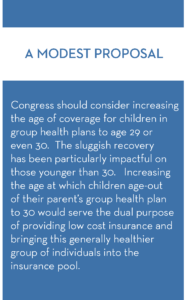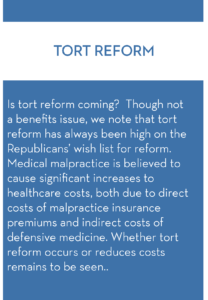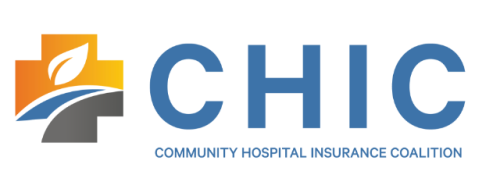Contents
Post-Election Returns: What Now for Obamacare?
FSA Update: IRS Increases Health FSA Contribution Limit for 2017, Adjusts Other Benefit Limits
Employer’s Guide to ACA Reporting — 2016
IRS Provides a 30-Day Extension for Furnishing Forms 1095 and Extends Good Faith Transition Relief
Did you know? Disability Employment Initiative
Post-Election Returns: What Now for Obamacare?
The votes have been counted and Donald Trump is the president-elect and Republicans control Congress. Among the many questions around the proverbial watercooler is what now for “Obamacare”? While it is impossible for anyone to predict the future, we undertake to make a short, best guess about the future of the Affordable Care Act (“ACA”).
As a candidate, Mr. Trump repeatedly vowed to “repeal and replace” the ACA. So, the first question is, inevitably, will the ACA be repealed and, if so, what will replace it?
As to repeal, it seems unlikely that 100% of the ACA will disappear. Many of the provisions of the ACA are favored by the country’s insured (even if not necessarily all that popular with carriers). ACA insurance reforms are popular. It is unlikely that the new President would seek to alienate Americans by rolling back these favored provisions of the ACA.

For example, under the ACA group health plans are not permitted to impose lifetime limits on most benefits. Prior to the ACA, lifetime limits were standard: if a participant exceeded an established lifetime dollar limit no further benefits would be payable under the plan. Lifetime limits do not increase the cost of insurance significantly (because so few participants actually ever exceed them), and they are favored by the insured, so it is unlikely that the elimination of lifetime limits will disappear.
Similarly, annual limits on essential health benefits will likely either survive repeal or re-appear in any replacement legislation, for the same reasons that lifetime limits will survive.
Extension of dependent coverage is another popular ACA provision that is likely to survive repeal. Prior to the ACA, children of parents covered under a group health plan would “age out” of their parent’s plan when they reached age 19, unless they were enrolled full-time in school and met certain other requirements, such as being unmarried. The ACA requires health plans to cover children up to the age of 26, regardless of dependent status and regardless of whether they live with their parents. Given the sluggish recovery of the U.S. economy, this provision of the ACA is likely one of the biggest successes. Young adults who were unemployed or underemployed would, prior to the passage of the ACA, remain uninsured. Traditionally, the uninsured rate for young adults is approximately one-third higher than for older employed adults. The increased coverage has made it possible for millions of young adults to be insured.
Another popular ACA provision is the guaranteed issue of health insurance. Under the ACA, group health plans have been required to eliminate all pre-existing condition exclusions. Some form of this concept will remain, but it is likely, based on the various Republican proposals that have been put forth over the last few years, that this provision may not survive in its current form. Instead, federal law may well revert to the previous portability provision in place before the ACA which would require insureds to maintain continuous coverage to avoid preexisting condition exclusions or limitations. Unlike the ACA provision, the prior law promotes responsible behavior: it encourages individuals to remain in the insurance pool even when they don’t need insurance, which will help to keep insurance costs down.
Tax credits to small businesses to buy insurance, another ACA provision, may survive with some changes in the replacement legislation. Medicare reform is also likely to survive, particularly the concept of Medicaid Expansion, albeit on a revamped basis.
There are other elements of the ACA that will likely survive repeal, but some of the key ACA provisions are likely to disappear. These can be grouped broadly into the category of “mandates.” As a candidate, President-elect Trump’s message that there are too many mandates coming out of Washington, D.C. seemed to resonate; clearly he has been given his own mandate to reduce these directives.
The first mandate that will likely fall on the new Administration’s chopping block is the “individual mandate,” which penalizes individuals who do not purchase insurance. The Republican Congress and the new President are not likely to continue to support a federal law that requires U.S. citizens to purchase a product from a non-public seller. Of course, the challenge for the new Administration and Congress will be to develop programs that will entice Americans to buy insurance—assuming the White House and Congress agree that attempting to get as close to 100% of Americans insured is still a priority for any new legislation.

Another key mandate that will likely disappear is the employer “pay-or-play” mandate. This, of course, would have a “HUGE” impact on businesses in America. A significant majority of the compliance efforts underway by employers under the ACA is devoted to addressing various rules that are in place because of the pay-or-play mandate, including establishing 30 hours a week as “full-time,” counting hours and developing complex methods for tracking “variable hour” employees, and, of course, completing and filing the ridiculously complex reporting forms (1094 and 1095). If the pay-or-play mandate is repealed, all this complex activity will cease, and the tens of thousands of pages of regulations implementing these rules will be consigned to the dustbin of history.
Finally, it appears that the Cadillac Tax, now scheduled to go into effect in 2020, will be eliminated.
So, what will replacement look like? Anyone who says he or she knows the answer to that question is fooling him/herself. President-elect Trump will likely spend considerable time between now and January 20, 2017 meeting with Senate and House leaders on both sides of the aisle and discussing the various proposals that have been advanced over the last few years. He and Congress will likely be ready in the opening days of the 115th Congress to implement either one or a series of laws that will repeal and replace the ACA. Ironically, because of Senate rules, the Republicans will likely use the same procedural loophole to pass repeal bills that the Democrats used to originally pass the law.
As a candidate, Mr. Trump focused primarily on some key issues that he believes will address the health care/insurance concerns in the U.S. Chief among his proposals is a plan to modify federal law to permit the sale of health insurance across state lines. Under current federal law the states are permitted to limit the sale of health insurance in their states. In some states this has led to only one or maybe two carriers “owning” the market. Increased competition across state lines, Mr. Trump believes, would reduce costs and lead to better products. From an employer’s perspective, it would seem that eliminating the ability of states to limit access to carriers would be helpful for single-state and multi-state employers.
Mr. Trump also called for increased use of Health Savings Accounts (HSAs). Again, improving access to and use of HSAs, and promoting consumerism by participants in group health plans would seem to be a positive development for employers, if it occurs.
When Mr. Trump talks to members of Congress on this issue he will find that there are many ideas—good and bad—that have been floated over the last few years. Key concepts that he might hear include the introduction of means-tested subsidies—not unlike the current subsidies available to purchase insurance through the Marketplace. Access will still have to be addressed, so it is likely that some elements of the current Marketplace methodology will survive.
The reality is that any change, if it includes access to affordable insurance, will be costly. How will new legislation pay for the changes? The most likely approach will be to modify the tax-preference provided to employer-provided health insurance. Many of the Republican proposals that have been put forth include either a phase out on tax-free premiums based on income levels or a phase out based on the total cost of premium. In the former, the proposals typically set a compensation limit at which the tax-free nature of insurance premiums begins to disappear. In the latter, the limit is placed on the value of the insurance, not unlike the current Cadillac Tax model, such that the tax-free premium disappears with more expensive coverage.
Under either scenario, tax dollars will be generated to pay for whatever replaces the ACA. It remains to be seen how employers will react, but it is doubtful—in our view—that employers will “get out of the business” of providing health insurance if the tax-free nature of the benefit is lost for some of its employees. Providing insurance will continue to be an important benefit. It is likely that employers will look for other benefits that might be offered—whether on a tax-free basis or not—to replace the lost tax-preference inherent in the current system.
It is impossible at this point to know what repeal and replace will look like. For now, we are encouraging employers to stay the course and continue to comply with current law. We can guess but we do not know what will stay and what will disappear, so it is better to continue doing what you’re doing, rather than potentially violating a law or set of rules that might remain in place.
Employers may be tempted to suspend all compliance efforts now, in an anticipation of the current change. That would be a mistake. Until the rules change, employers are well advised to stay the course.
FSA Update: IRS Increases Health FSA Contribution Limit for 2017, Adjusts Other Benefit Limits
On October 25, 2016, the Internal Revenue Service (IRS) released Revenue Procedure 2016-55, which raised the health Flexible Spending Account (FSA) salary reduction contribution limit to $2,600 for plan years beginning in 2017. The Revenue Procedure also released the cost-of-living (COLA) adjustments that apply to dollar limitations in certain sections of the Internal Revenue Code (Code). The following summarizes other adjustments relevant to individuals and employer sponsors of welfare and fringe benefit plans.
Refundable Credit for Coverage Under a Qualified Health Plan
For taxable years beginning in 2017, the limit on repayment of excess advance premium credits is determined using the following table:
| If the household income (expressed as a percent of the federal poverty line) is: | The limitation amount for unmarried individuals (other than surviving spouses and heads of household) is: | The limitation amount for all other taxpayers is: |
| Less than 100% | $0 (no repayment) | $0 (no repayment) |
| At least 100% but less than 200% | $300 | $600 |
| At least 200% but less than 300% |
$750 | $1,500 |
| At least 300% but less than 400% | $1,275 | $2,550 |
| Over 400% of the federal poverty line | No cap (full amount repaid) | No cap (full amount repaid) |
In other words, individuals who were ultimately ineligible for the premium credits they received will have their repayment capped based on the table above.
Qualified Commuter Parking and Mass Transit Pass Monthly Limit Increase
For tax year 2017, the monthly limitation for the qualified transportation fringe benefit is $255, as is the monthly limitation for qualified parking. The Consolidated Appropriations Act of 2016 permanently restored the parity to the tax exclusion for parking and mass transit. The prior discrepancy between parking and mass transit had become regularly addressed by last minute, short-term fixes by congress.
Small Employer Health Insurance Tax Credit Average Annual Wage Limit Increase
For taxable years beginning in 2017, the maximum average annual wages of employees used for determining who is an eligible small employer for purposes of the credit is $52,400.
Adoption Assistance Tax Credit Increase
For taxable years beginning in 2017, the amount that can be excluded from an employee’s gross income for the adoption of a child with special needs is $13,570. The maximum amount that can be excluded from an employee’s gross income for the amounts paid or expenses incurred by an employer for qualified adoption expenses furnished pursuant to an adoption assistance program for other adoptions by the employee is $13,570. The amount excludable from an employee’s gross income begins to phase out for taxpayers with modified adjusted gross income in excess of $203,540 and is completely phased out for taxpayers with modified adjusted gross income of $243,540 or more.
Reminder: HSA Self-Only Coverage Contribution Limit Increases to $3,400
Earlier this year, the IRS announced the inflation adjusted amounts for 2017 HSA contributions in Revenue Procedure 2016-28. For individuals in self-only coverage, the 2017 contribution limit will increase to $3,400 (up from $3,350). The family coverage contribution limit remains at $6,750 again in 2017. All other limits remain unchanged from 2016. The following table summarizes the limits relevant to HSAs and high deductible health plans (HDHPs).
| 2017 (single/family) | 2016 (single/family) | |
| Annual HSA Contribution Limit | $3,400 / $6,750 | $3,350 / $6,750 |
| Minimum Annual HDHP Deductible | $1,300 / $2,600 | $1,300 / $2,600 |
| Maximum Out-of-Pocket for HDHP | $6,550 / $13,100 | $6,550 / $13,100 |
Lastly, the ACA’s out-of-pocket limits for in-network essential health benefits have increased for 2017. Don’t forget that starting with 2016 plan years, all non-grandfathered group health plans must contain an embedded individual out-of-pocket limit within family coverage, if the family out-of-pocket limit is above $6,850 (2016 plan years) or $7,150 (2017 plan years). Exceptions to the embedded out-of-pocket limit rule also apply for certain small group plans eligible for transition relief.
| 2017 (single/family) | 2016 (single/family) | |
| ACA Maximum Out-of-Pocket | $7,150 / $14,300 | $6,850 / $13,700 |
Employer’s Guide to ACA Reporting — 2016

If you are an employer with 50 or more full-time equivalent employees and employers of any size with self-insured plans. Please click here to read our guide to the final ACA reporting forms and instructions for 2016. It is a robust document that addresses the forms and instructions in detail, including the latest guidance on social security number solicitation and opt-out payments.
IRS Provides a 30-Day Extension for Furnishing Forms 1095 and Extends Good Faith Transition Relief
The Internal Revenue Service (IRS) has released Notice 2016-70, which extends the deadline for furnishing Forms 1095-B and 1095-C to individuals from January 31, 2017 to March 2, 2017. The Notice did not delay the due date for filing the forms with the IRS, which remains February 28 if filing by paper, or March 31 if filing electronically.
The instructions to Forms 1094-C and 1095-C provide that employers can request a 30-day extension to furnish statements to individuals by sending a letter to the IRS that includes the reason for delay. However, because the Notice’s extension of time to furnish the forms is more generous than the 30-day extension contained in the instructions, the IRS will not formally respond to requests for an extension of time to furnish 2016 Forms 1095-B or 1095-C to individuals.
Employers may still obtain an automatic 30-day extension for filing with the IRS by filing Form 8809 on or before the forms’ due date. An additional 30-day extension is available under certain hardship conditions.
The Notice encourages employers who cannot meet the extended due dates to furnish and file as soon as possible. The IRS will consider whether employers have made reasonable attempts to comply with the requirements and the steps that have been taken to prepare for next year’s (2017) reporting when determining whether to abate penalties for reasonable cause.
Like last year, taxpayers can file their personal income tax return without having to attach the relevant Form 1095 to their tax returns. Taxpayers should keep these forms in their personal records.
The Notice also extends last year’s good-faith transition relief from penalties for incorrect or incomplete information on the forms. These penalties can be waived for employers who can show that they made good-faith efforts to comply. The good-faith relief applies only to furnishing and filing incorrect or incomplete returns, and not timeliness failures. However, if an employer is late filing a return, it may be possible to get penalty abatement for failures that are due to reasonable cause and not willful neglect.
Employers should note that the IRS does not anticipate extending transition relief – either with respect to the due dates or with respect to good faith relief from penalties – to reporting for 2017.
As part of the Disability Employment Initiative (DEI), the U.S. Department of Labor (DOL) recently awarded a total of $14.9 million in grants to six states. The specific amount awarded to each state is as follows:
| – | California—$2,500,000 | |
| – | Connecticut—$2,500,000 | – | Idaho—$2,500,000 | – | Massachusetts—$2,500,000 | – | Minnesota—$2,500,000 | – | Maryland—$2,472,986 |
Among other things, the grant money will be used to improve employment outcomes, diversify training opportunities, build community partnerships and design flexible and, if necessary, customized strategies for training and support for individuals with disabilities.

Take the Community Hospital Insurance Coalition (CHIC) for example. With our expert support and management, more than 30 rural hospitals who have come together to own this medical stop-loss reinsurance company. They are paying less for their insurance, improving benefits program performance, and receiving their share of a significant annual surplus cash distribution (~$2.5 million since inception in 2018).


